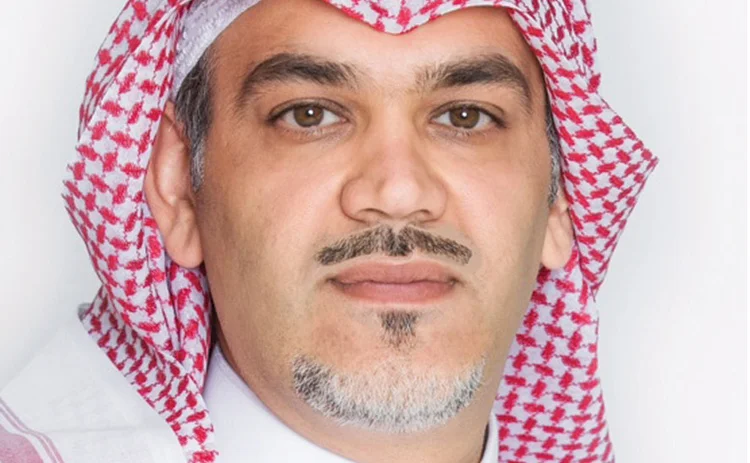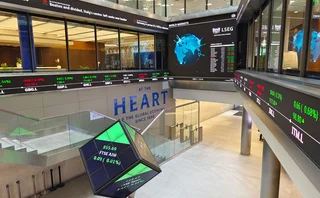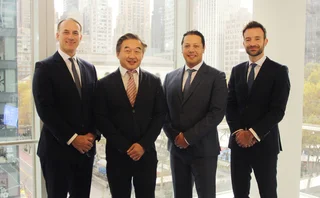
Sovereign risk manager of the year: Debt Management Office of Saudi Arabia
Risk Awards 2018: New DMO is building a benchmark curve that could spur local capital markets

Until Saudi Arabia created a debt management office (DMO) two years ago, fixed-income investors in the country had a big problem. In the absence of any sovereign bond issuance, there was no benchmark yield curve from which other debt values could be derived. According to a credit trader at a European investment bank in Abu Dhabi, the only way around it was a convoluted – and imperfect – process involving proxy issuers and credit default swaps (CDSs).
“Before, the proxy was basically Saudi Electricity Company – Seco – because a lot of people see them as similar to sovereign risk,” the credit trader says. “People would basically look at the Seco curve, and treat it as Saudi Arabia plus a certain spread. But it was quite difficult to assess what that spread should be above the sovereign. People would use Saudi CDSs, which could never default because they had no underlying.”
As a result, the potential of the local corporate bond market was crimped.
“There was no government curve, there was hardly any issuance out there,” says Abhishek Kumar, vice-president and lead portfolio manager of emerging market fixed income at State Street Global Advisors.
The sovereign’s commitment to a programme of regular bond issuance is changing that – creating a foundation on which local capital markets can build and potentially opening a new financing avenue for the kingdom’s bank-dependent companies. Seen in this light, the creation of a DMO and an accompanying public debt management framework, is a huge risk-mitigation project – one of the key reasons why the office wins this year’s award.
But the award is also a reflection of how the DMO has managed the risks of each new bond issuance. This is no mean feat for a young DMO – operational risk is naturally high in a new organisation made up of newly assembled individuals and newly devised processes. The success of the DMO’s issuances to date, however, show it rising to the challenge. With the $17.5 billion it raised from international investors in 2016, the DMO set a new emerging market record, and each subsequent international and local bond has been heavily oversubscribed by investors.
“They have been doing an extremely good job,” says the Abu Dhabi-based credit trader. “They are all ex-bankers, so have a very good understanding of the market, and they keep in touch with the traders. They are very interested in making sure there is a functioning and liquid market.”
Big strides towards these goals have been made over the past year. The DMO issued its first dollar-denominated Islamic bond – known as sukuk – in April, raising a total of $9 billion across five- and 10-year tranches. Since July, the group has issued 47 billion riyal ($12.5 billion) of sukuk across a monthly programme targeting the five-, seven- and 10-year maturity buckets. Finally, a further $12.5 billion on international markets was raised in September. Liquidity across the various points of the curve is building.
We don’t have an active risk management policy when it comes to interest rates, because currently we are very satisfied with the mix of fixed to floating debt we have in our portfolio
Fahad Al-Saif, DMO president
“We had to come up with a strategy to plot as many points into the new local risk-free curve, through local issuances from our sukuk programme,” says Fahad Al-Saif, a former HSBC banker who is now president of the DMO. “We need to ensure we have enough points in our curve for it to become the benchmark of the financial services community. At the moment, we are keen to continue with five, seven and 10 every month, rolled over to create a sufficient quantum of debt.”
The Abu Dhabi-based credit trader goes so far as to say the Kingdom of Saudi Arabia now boasts the most liquid risk-free curve in the Middle East. “KSA is now the Middle East proxy,” he says. “For investors who do not look at the region often but want an idea of how it has moved, they should look at KSA, because it is now by far the most liquid curve we trade in the Middle East.”
Some impact is already being seen in the local capital markets. A total of $9.6 billion has so far been issued by Saudi Arabian corporates in the year to date, up 132% from the $4.1 billion companies tapped over the same period last year, according to data supplied by Thomson Reuters.
“Suddenly, in 2017, it has really picked up,” says SSGA’s Kumar. “Only now is there some activity. If you really want to develop a bond market, you need to have longer-dated bonds, and that was what was missing. This proves the point that the real issue [holding the corporate bond market back] was a lack of liquid government bonds.”
Reliable, credible, transparent
Issuing sovereign bonds may be helping to mitigate risk in the Saudi banking sector, but the activity inevitably creates a number of new exposures the DMO must manage.
Since the riyal is pegged to the US dollar, the DMO has not had any need to use derivatives to manage foreign exchange exposures to date. Preparations are underway, though, in case it decides to issue debt in other currencies – such as euro or yen – in the future. The DMO is currently putting International Swaps and Derivatives Association documentation in place with its banks so the office can pounce if it spots an opportunity in another currency. But for the meantime, the main focus of the DMO, when it comes to market risks, are interest rate and liquidity risks.
On the former, the DMO has sought to establish a natural hedge by achieving a suitable balance between fixed and floating debt in the sovereign bond portfolio. At present, this is weighted at 70% fixed and 30% floating, a distribution Al-Saif says will insulate the sovereign from any adverse moves in interest rates in the short to medium term.
“We don’t have an active risk management policy when it comes to interest rates, because currently we are very satisfied with the mix of fixed to floating debt we have in our portfolio,” says Al-Saif. “Our liability management team, specifically the interest rate function within the team, continue to observe this to ensure we maintain the right risk parameters, knowing the markets can change at any point in time.”
Transparency, meanwhile, is key to protecting the DMO from liquidity risks that could cause it to have difficulty in raising cash over a short period of time. With that in mind, the DMO has focused principally on developing its investor relations strategy, so there is strong two-way communication between the office and the buyers of the kingdom’s bonds.
“The DMO is committed to being a reliable, credible and transparent issuer,” says Al-Saif. “We have been focusing a lot on the investor relations strategy. We are committed to conducting investor roadshows, and have frequent calls with investors, credit analysts, and credit traders. We define who the stakeholders are when it comes to our secondary and primary market, and try to ensure there is as much transparency as we are able to share with respect to the progress we are making in our medium-term strategy.”
The liability portfolio management team continuously analyse and assess the market availability, the average term maturities, the average term re-fixings for the local portfolio, our floating to fixed benchmark and our local to international ratios
Fahad Al-Saif, DMO president
A quantitative approach is also taken to analysing and mitigating liquidity risk, Al-Saif says. The liability portfolio management team performs an ongoing analysis of the portfolio and its position, using a range of key performance indicators and benchmarks. The information is then used to establish, with input from the front office, the optimal issuance strategy.
“The liability portfolio management team continuously analyse and assess the market availability, the average term maturities, the average term re-fixings for the local portfolio, our floating to fixed benchmark and our local to international ratios. Then there is very robust communication between liability management and the front-office functions, both of whom have a mutual interest in making sure we don’t flood a particular market.”
“We are also always trying to ensure the local market is deepening and that we are getting as much diversity as possible into the investor group,” he adds. “We try to work out when we should be embarking on a particular transaction based on liability management and also the cashflow management requirements.”
The DMO’s work has already had an impact on perceived risk to the economy. In March, Moody’s Investors Service revised its outlook for the Saudi banking sector to stable from negative. In the rating agency’s report, “liquidity injections from international sovereign debt issuances” were cited as a reason for the improved resilience of a sector that has struggled as a result of falling oil prices.
Only users who have a paid subscription or are part of a corporate subscription are able to print or copy content.
To access these options, along with all other subscription benefits, please contact info@risk.net or view our subscription options here: http://subscriptions.risk.net/subscribe
You are currently unable to print this content. Please contact info@risk.net to find out more.
You are currently unable to copy this content. Please contact info@risk.net to find out more.
Copyright Infopro Digital Limited. All rights reserved.
As outlined in our terms and conditions, https://www.infopro-digital.com/terms-and-conditions/subscriptions/ (point 2.4), printing is limited to a single copy.
If you would like to purchase additional rights please email info@risk.net
Copyright Infopro Digital Limited. All rights reserved.
You may share this content using our article tools. As outlined in our terms and conditions, https://www.infopro-digital.com/terms-and-conditions/subscriptions/ (clause 2.4), an Authorised User may only make one copy of the materials for their own personal use. You must also comply with the restrictions in clause 2.5.
If you would like to purchase additional rights please email info@risk.net
More on Awards
Clearing house of the year: LCH
Risk Awards 2025: LCH outshines rivals in its commitment to innovation and co-operation with clearing members
Best use of machine learning/AI: CompatibL
CompatibL’s groundbreaking use of LLMs for automated trade entry earned the Best use of machine learning/AI award at the 2025 Risk Markets Technology Awards, redefining speed and reliability in what-if analytics
Markets Technology Awards 2025 winners’ review
Vendors jockeying for position in this year’s MTAs, as banks and regulators take aim at counterparty blind spots
Equity derivatives house of the year: Bank of America
Risk Awards 2025: Bank gains plaudits – and profits – with enhanced product range, including new variants of short-vol structures and equity dispersion
Law firm of the year: Linklaters
Risk Awards 2025: Law firm’s work helped buttress markets for credit derivatives, clearing and digital assets
Derivatives house of the year: UBS
Risk Awards 2025: Mega-merger expected to add $1 billion to markets revenues, via 30 integration projects
Interest rate derivatives house of the year: JP Morgan
Risk Awards 2025: Steepener hedges and Spire novations helped clients navigate shifting rates regime
Currency derivatives house of the year: UBS
Risk Awards 2025: Access to wealth management client base helped Swiss bank to recycle volatility and provide accurate pricing for a range of FX structures







